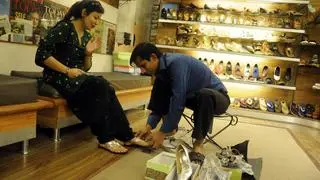In Paris, couture capital of the world and engine of the fantasy and fable that drive our desire for fashion, skilled petite mains (seamstresses) who are noted for spinning beautiful and outrageous designs into fabric, are currently engaged in the urgent task of stitching masks for medical workers.
Legendary fragrance houses such as Guerlain, Dior and Givenchy are now manufacturing factory-loads of hand sanitiser for free distribution to hospitals across France. Their counterparts in Italy and the US have followed suit, as have high-street giants such as H&M and Zara. Grassroots and independent designers are printing out free designs for home-made cloth masks.
Closer home, Indian fashion leaders are participating in a patchwork effort to fund-raise for artisans, debate the future of fashion and simply stay afloat (cue giftcards, deep discounts, online bazaars).
The Empress wears sweatpants
The business of fashion is one of the largest in the world, and the textiles and apparel industry is the second-largest employer in India. As production and supply lines come to a halt and livelihoods get impacted, our relationship with fashion as a cultural force is also becoming increasingly precarious.
Days packed with work, family and all manner of chores call for clothes that are functional and comfortable. Even Anna Wintour, unelected Empress of Fashion, was spotted wearing sweatpants on Vogue ’s Instagram page. Fashion devotees — influencers, celebrities and ordinary civilians — are thinking aloud about cutting back on their fashion fixes and unthinking purchases. How can an industry whose most elite tiers are dedicated to the beautiful and ephemeral, retain any meaning in times like these?
Style as celebration and control
Fashion has always had its naysayers and the pandemic will simply confirm their beliefs about its essential superfluity. For others, the sudden limitation in where they can go and what they are wearing only renews fashion’s importance. Reduced to the same rotating cast of clothes that everyone we know seems to be wearing (anything that’s wrinkle-proof, stretchy, withstands stains), we have a renewed appreciation for being able to pick out something different to wear every day.
To say that assembling an outfit is an exercise in trying to keep up with trends is not just predictable, but inaccurate. It is also an exercise in self-expression and individuality, a way to communicate and signal intent to others. Dressed up or dressed down or just right, we’re making a point, if not exactly proving one.
There’s something to be said for the simple tactile and sensory pleasures of selecting clothes and accessories that are multi-hued and textured. One person we spoke with talked about missing the satisfying crispness of a freshly ironed shirt. Someone else spoke about missing heels after days of flopping about in chappals. If we contain multitudes, then our clothes equip us to play the many different roles that keep us whole.
Some people are taking back control over their messy schedules by dressing up and bravely posting their #OOTDs (outfits of the day). They’re dressing for Zoom parties, with clothing becoming an important way in which to keep things celebratory during birthdays, reunions and anniversaries. For others, outfits are less about specialness and more about taking back control. Changing clothes during the day gives them a sense of transitioning from work to home and back again.
Looking the part: Rituals & DIY
When we talk about clothes, we must also talk about the ‘look.’ The lipstick effect (the continued purchase of small indulgences during economically challenging times) is more than an economic phenomenon. Whether it’s nail-polish, lipstick or even clipping on a pair of earrings, people report feeling better when they keep their pre-Covid styling rituals going. As with clothes, it’s about taking the initiative to express and project yourself on your own terms. With influencers and DIY (do-it-yourself) tutorials galore, others are cultivating beauty routines for the first time, playing around with make-up and taking aesthetic risks that they wouldn’t have imagined taking in ordinary times.
Social media feeds are filled with stories of people experimenting with at-home cuts and treatments. Anushka Sharma famously trimmed Virat Kohli’s hair. Oprah Winfrey has posted stories of her partner Stedman setting up an at-home salon for their extended family. Eva Longoria shot a video of herself touching up her roots using a $9 store-bought box of colour that the brand might turn into a commercial.
Even the ordinary and non-famous are reporting styling successes and disasters with equal glee, suggesting that there’s a greater willingness to ‘go with the flow’ and to see how beauty experiments might actually unfold. After all, even the sharpest critic with the keenest eye would be hard-pressed to judge someone for trying something new during lockdown.
Renewal or irrelevance?
But for every person who spruces up for an important work meeting, is another who opts to keep the video off, liberated from any need to look the part. Much as they might miss their local barbershop or parlour, they see these as spaces to be visited, not recreated in a home-made avatar.
It seems that when it comes to fashion and beauty, there is no middle-ground between reinforced relevance and studied indifference. Both industries are struggling with long-term questions about sustainability, wastefulness and affordability. Do we really need fashion seasons with bags and make-up palettes to match? Do we still require the complete paraphernalia of fashion weeks, shows and shoots? Shouldn’t we be committing to more thoughtful consumption of brands that tangibly mirror our priorities – local craftsmanship, careful sourcing, equitable pay?
But while the business of fashion and beauty has scaled in ways that defy logic and good sense, it’s almost impossible to deny the depth of its continuing influence. At their best, these businesses can be expressive, creative, avant garde . A survey I filled the other day asked me whether I would want brands in the future to reassure me or keep me dreaming. It seems that in a post Covid world, our fashion and beauty brands will have to take on the onus of doing both.

(This essay is part of a larger project called Covid Chronicles, the DDB Mudra Group’s exploration of changes in consumer behaviour and culture during the pandemic. Led by Toru Jhaveri (VP & Head of Strategy – DDB Mudra West) and curated by a team of strategists (Aditya, Ellina, Nandan and Somdatta), Covid Chronicles draws on a mix of proprietary tools and is updated every week. Follow @ddbearshot on Instagram to get our updates.)








Comments
Comments have to be in English, and in full sentences. They cannot be abusive or personal. Please abide by our community guidelines for posting your comments.
We have migrated to a new commenting platform. If you are already a registered user of TheHindu Businessline and logged in, you may continue to engage with our articles. If you do not have an account please register and login to post comments. Users can access their older comments by logging into their accounts on Vuukle.